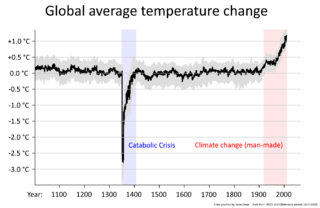Catabolic Crisis: Difference between revisions
mNo edit summary |
mNo edit summary |
||
| Line 4: | Line 4: | ||
| above = Catabolic Crisis | | above = Catabolic Crisis | ||
| image = [[File:Global average temperature change for Teleon.png|320px]] | | image = [[File:Global average temperature change for Teleon.png|320px]] | ||
| caption = Graph of global mean temperatures from 1000 BCE to 2000 BCE with the steep period of {{wp|global cooling}} of the Catabolic Crisis shown in blue | | caption = Graph of global mean temperatures from 1000 BCE to 2000 BCE with the steep period of {{wp|global cooling}} of the Catabolic Crisis (expanded timespan definition) shown in blue | ||
| header1 = | | header1 = | ||
| label1 = {{Nowrap|Other names}} | | label1 = {{Nowrap|Other names}} | ||
Revision as of 14:42, 5 July 2024
This article is incomplete because it is pending further input from participants, or it is a work-in-progress by one author. Please comment on this article's talk page to share your input, comments and questions. Note: To contribute to this article, you may need to seek help from the author(s) of this page. |
| Catabolic Crisis | |
|---|---|
 Graph of global mean temperatures from 1000 BCE to 2000 BCE with the steep period of global cooling of the Catabolic Crisis (expanded timespan definition) shown in blue | |
| Time | 1348–1353 (approximate estimate); long-term effects lasting throughout the 14th century |
| Place | Worldwide, especially in the Northern Hemisphere (Abaria, Calesia, North Hylasia) |
| Event | Impact winter caused by the Catabole with maximum global mean temperature drop of 2.7 °C (4.9 °F) |
| Deaths | 25,000,000–50,000,000 in Calesia; more than 130,000,000 worldwide (estimated) |
The Catabolic Crisis, historically referred to as the Years Without Warmth, was a period in Calesian history and to a broader extent world history from 1348 to 1353 marked by extreme weather and subsequently ensuing economic, political, and social strife; Calesia and Hylasia in particular were the most severly affected regions.
The historic and scientific consensus is that the main cause of the crisis was the 1348 Catabole, an asteroid impact event in the X that devastated vast swaths of Calesia, East Abaria and North Hylasia and initiated an impact winter. While several other causes have been proposed and are still debated, it is generally accepted that the vaporization of enormous quantities of gypsum from the shallow seabed of the impact site and their subsequent dispersal into the atmosphere cooled the planet. Recent climate modeling suggests the global climate underwent a cooling of about 2.7 °C (4.9 °F) during the first four years before returning to less than 1 °C (1.8 °F) within two decades; for that reason, experts have proposed alternative timespans to denote the crisis from about 1350 to 1450.
Summer temperatures in Calesia during that period were the coldest of any on record between 1000 BCE and 2000 BCE, and the same was the case for Abarian history. The immediate result was widespread crop failure and the swift spread of famine. Countries in Calesia that were still trying to recuperate following the devastating Catabole, such as Hyacinthe, X, and X, suffered significant hardships and battled a popular uprising amidst food shortages. The famine was the second-worst to affect Calesia after the Famine of 1290. Concurrently, abhorrent sanitary conditions and chronic malnourishment paved the way for a devastating epidemic of cholera and the bubonic plague to sweep through the X from 1350 to 1353.
The crisis had profound effects on the course of world history. The eras of prosperity of multiple Calesian powers such as Waldrich, Hyacinthe, and X were cut short by the events, the Robindian Civil War in Falland ended inconclusively, religious divisions would escalate into the !Reformation, and in Elia Australis, the chaos allowed the Huecean Empire to eventually rise to power. Estimates on the number of deaths range considerably, but at least 25–50 million (30% to 60%) of Calesia's population, and about 130 million (35%) of the entire world population fell victim to the causes and their related effects.
